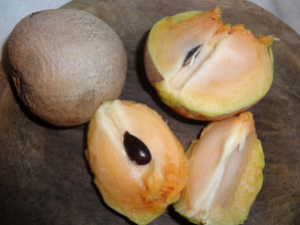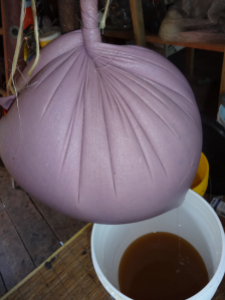 Making Coconut cream and flour involves quite a few steps, a little muscle, time and diligence. When you do everything from scratch, you realise the value of what you are actually making. The making of the cream and flour go hand in hand as you will see from the following steps:
Making Coconut cream and flour involves quite a few steps, a little muscle, time and diligence. When you do everything from scratch, you realise the value of what you are actually making. The making of the cream and flour go hand in hand as you will see from the following steps:
Firstly, Gnome has to climb a coconut tree to harvest and then he de-husks them. Next, he splits them in half and grates the flesh with a shredder attached to a hand-drill.

The next step is to squeeze the liquid out of the coconut. I usually add some boiling water to the coconut and I squeeze the shredded coconut through a muslin cloth to get all the milk and cream out. This is done in small portions in order to maximise the quantity and once all the milk/cream has been extracted, the shredded coconut is placed in trays and laid outside to sun-dry.

Meanwhile, the liquid is placed in the fridge and as it cools down, the milk separates to the bottom and the cream forms a layer a the top. The cream is skimmed off the top, a number of times, and poured into these bags for selling:

Each bag contains the fresh cream of one coconut. Belizeans like to cook rice with this; a Belizean cook in Punta Gorda told me that he just needed one of these bags to cook a 5lb pot of rice. Another great way to use this cream is to indulge in a pina colada or blend with fruit to make a yummy coconut “shake.” You can even use it in bread making to give a silky texture to a loaf.
Usage and Storage of Coconut Cream:
Our coconut cream is sold in the frozen state. Store in the freezer. When you are ready to use, simply use it in the frozen state. If you only require a small amount, cut off a chunk with a knife and store the remaining cream in the freezer. The shelf life of this product is 6 months if stored properly in the freezer.
Anyway, back to the shredded coconut; it takes about 6 to 8 hours for it to completely dry in the sun. Once dried, the coconut is put through a stone mill to grind it into flour. You end up with a fluffy meal which is perfect for breads, pancakes and muffins and it is has the added bonus of being gluten-free.

The coconut flour has a nutty flavour which adds texture to all kinds of foods. 1lb (454g) of this flour contains the meal of about 6 to 7 coconuts.
Usage and Storage of Coconut Flour:
Coconut flour is highly nutritious so should be stored in the refrigerator or freezer. The coconut flour can be stored in the fridge for up to 2 weeks. Otherwise, it can be stored in the freezer for up to 6 months. We usually deliver this product in the frozen state; in order to thaw this product, simply place in the fridge for 24 hours.
We are currently selling coconut cream, stone-ground coconut flour and rice flour within Belize. The coconut cream can only be sold within Punta Gorda. However, flours can be transported anywhere within Belize. Please check out The Apothecary for our Health Food prices.


















